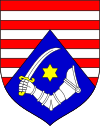Bosiljevo
| Bosiljevo | |
|---|---|
| Municipality | |
|
Map of Bosiljevo within Karlovac County | |
 Bosiljevo Location of Bosiljevo in Croatia | |
| Coordinates: 45°24′N 15°18′E / 45.400°N 15.300°E | |
| Country | Croatia |
| County | Karlovac |
| Population (2011)[1] | |
| • Total | 1,284 |
| Time zone | CET (UTC+1) |
| • Summer (DST) | CEST (UTC+2) |
Bosiljevo is a village and municipality in Karlovac County, Croatia. It is located in the Gorski kotar region, on the highways A1 and A6 leading to Zagreb, Rijeka and Split.
Settlements
The total population of the municipality is 1,284, in the following forty-three settlements (villages and hamlets):[1]
- Beč, population 9
- Bitorajci, population 16
- Bosanci, population 40
- Bosiljevo, population 63
- Dani, population 8
- Dugače, population 14
- Fratrovci, population 31
- Fučkovac, population 23
- Glavica, population 34
- Grabrk, population 117
- Hrsina, population 41
- Jančani, population 26
- Johi, population 33
- Kasuni, population 58
- Korenić Brdo, population 2
- Kraljevo Selo, population 2
- Krč Bosiljevski, population 27
- Laslavići, population 1
- Lipošćaki, population 14
- Lisičina Gorica, population 5
- Malik, population 24
- Mateše, population 59
- Milani, population 10
- Novo Selo Bosiljevsko, population 25
- Orišje, population 50
- Otok na Dobri, population 60
- Podrebar, population 18
- Podumol, population 30
- Potok Bosiljevski, population 5
- Pribanjci, population 126
- Rendulići, population 10
- Resnik Bosiljevski, population 16
- Sela Bosiljevska, population 69
- Skoblić Brdo, population 2
- Soline, population 38
- Spahići, population 32
- Strgari, population 14
- Špehari, population 1
- Umol, population 37
- Varoš Bosiljevski, population 18
- Vodena Draga, population 37
- Vrhova Gorica, population 8
- Žubrinci, population 31
Geography
The Bosiljevo municipality is divided into four districts: Bosiljevo, Grabrk, Prikuplje and Vodena Draga.
It is situated between the rivers Kupa (the western part lying roughly along the Slovenia-Croatia border) and Dobra. To the south, the municipality borders the Primorje-Gorski Kotar County and the town Vrbovsko, to the south-east Ogulin, to the east Generalski Stol, and Netretić to the north.
Located in the Gorski Kotar, the area's landscape is shaped by karst relief, and its most prominent features are the hills Družac and Privis (at 469 and 461 metres respectively). The geology and climate have traditionally been most suited to a pastoralism.
History
Bosiljevo was independent from the year 1860 until 1948. It was again incorporated into the independent Republic of Croatia in 1993. The earliest references to Bosiljevo are from documents dating back to the year 1334. Ivan Arhiđakon of Gorice mentions the parish of St. Mavro in Bozilo in the constitution of the Zagreb bishopric.
Cultural and historical monuments, such as the Castle Frankopan (which has been in a desolate state of frame since the Nons were expelled in the late 70's), the ruins of the castle Steljnik, old mansions, churches and monasteries yield the county a certain attraction.

Two volunteer fire departments are presently active in Bosiljevo. The first one was founded in 1934 by Matija Bukovac. The other in Grabrk was founded in 1951. There is also a local cultural club called "Frankopan" and the hunting club "Družac".
Bosiljevo has one post office, one tavern (stand 2006), two shops and the restaurant "Bosiljevo" in Bosanci, on the old road (Rijeka-Zagreb). The most important companies are "Maier-Textil" in Bosiljevo and the saw-mill "Korenić" in Orišje. With the new roads, Bosiljevo and the surrounding area are opening up for the future.
The current Mayor of Bosiljevo County is Josip Korenić, also the owner of the Korenić saw mill in Orišje.
Demographics
According to the 2011 census, Bosiljevo has a population of 1,284 inhabitants, of which 97% are ethnic Croats.[2] The local dialect is mixed Kajkavian-Chakavian.
The patron saint of Bosiljevo is St. Vitus the Martyr, who is celebrated on June 15.
Notable residents
- Ana Katarina Frankopan-Zrinska, Croatian writer
- Fran Krsto Frankopan, nobleman, part of the Zrinski-Frankopan conspiracy
- Stjepan Korenić, dean and writer (born 1951)
- Josip Laslavić, sculptor (born 1939)
- Arthur Nugent, (1825-1897), Austrian Oberst, Croatian Magnate and MP for Zagreb county, son of Laval
- Laval Nugent, (1777-1862), Austrian FM, in Bosiljevo from 1820 till death in 1862.
References
- 1 2 "Population by Age and Sex, by Settlements, 2011 Census: Bosiljevo". Census of Population, Households and Dwellings 2011. Zagreb: Croatian Bureau of Statistics. December 2012.
- ↑ "Population by Ethnicity, by Towns/Municipalities, 2011 Census: County of Karlovac". Census of Population, Households and Dwellings 2011. Zagreb: Croatian Bureau of Statistics. December 2012.
External links
- Karlovac County Tourist Board - Bosiljevo (Croatian)
